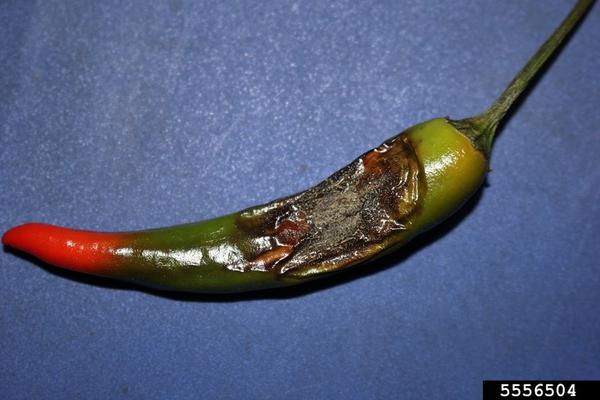Anthracnose of Pepper
go.ncsu.edu/readext?794437
en Español / em Português
El inglés es el idioma de control de esta página. En la medida en que haya algún conflicto entre la traducción al inglés y la traducción, el inglés prevalece.
Al hacer clic en el enlace de traducción se activa un servicio de traducción gratuito para convertir la página al español. Al igual que con cualquier traducción por Internet, la conversión no es sensible al contexto y puede que no traduzca el texto en su significado original. NC State Extension no garantiza la exactitud del texto traducido. Por favor, tenga en cuenta que algunas aplicaciones y/o servicios pueden no funcionar como se espera cuando se traducen.
Português
Inglês é o idioma de controle desta página. Na medida que haja algum conflito entre o texto original em Inglês e a tradução, o Inglês prevalece.
Ao clicar no link de tradução, um serviço gratuito de tradução será ativado para converter a página para o Português. Como em qualquer tradução pela internet, a conversão não é sensivel ao contexto e pode não ocorrer a tradução para o significado orginal. O serviço de Extensão da Carolina do Norte (NC State Extension) não garante a exatidão do texto traduzido. Por favor, observe que algumas funções ou serviços podem não funcionar como esperado após a tradução.
English
English is the controlling language of this page. To the extent there is any conflict between the English text and the translation, English controls.
Clicking on the translation link activates a free translation service to convert the page to Spanish. As with any Internet translation, the conversion is not context-sensitive and may not translate the text to its original meaning. NC State Extension does not guarantee the accuracy of the translated text. Please note that some applications and/or services may not function as expected when translated.
Collapse ▲Pathogen
Anthracnose is caused by a group of fungi within the genus Colletotrichum. The two main species associated with peppers are C. gloesporiodes and C. acutatum, but there are several species that may cause this disease.
C. gloesporiodes is more likely to infect mature fruit, whereas C. acutatum is more likely to infect immature fruit. Many species of Colletotrichum infect more than one host and more than one species may infect a single host.
Host Crops
Anthracnose is known to infect a wide range of commercial pepper plants and related solanaceous crops. Extensive outbreaks have occurred on bell peppers and specialty hot peppers.
Host Parts Affected
All above-ground parts of the plant are susceptible to infection, but the fruits are most impacted by this disease. Ripe and over-ripe fruit tend to be more susceptible, but pepper plants can become infected at any growth stage, as well as at post-harvest.
Identification
 Fruit lesions are the most common symptom. Initially, the lesions are small, depressed, and circular. As the disease progresses, they become much larger and develop mats of salmon to pink-colored spores, causing their surface to appear wet and gelatinous. The centers of the lesions can range from tan, orange, brown, or black. The colored spore mats seen on the fruit features are characteristic of this disease. Concentric circles commonly surround the lesions. Eventually, the entire fruit will rot. Anthracnose can cause a latent infection where contaminated, immature fruits may not show symptoms of disease until fully mature.
Fruit lesions are the most common symptom. Initially, the lesions are small, depressed, and circular. As the disease progresses, they become much larger and develop mats of salmon to pink-colored spores, causing their surface to appear wet and gelatinous. The centers of the lesions can range from tan, orange, brown, or black. The colored spore mats seen on the fruit features are characteristic of this disease. Concentric circles commonly surround the lesions. Eventually, the entire fruit will rot. Anthracnose can cause a latent infection where contaminated, immature fruits may not show symptoms of disease until fully mature.
Favorable Environmental Conditions
The pathogen prefers temperatures of around 80⁰F (27⁰C) and high levels of precipitation. The pathogen survives inside or on the surface of seeds. It can also over-winter in soil in the form of microsclerotia, which are very small, compact masses of hardened mycelium containing nutrient reserves for extreme conditions. Rain splash carries fungal spores from infected soil, plant debris, and/or fruits onto nearby plants. Excess rain can lead to higher rates of infection and crop loss.
General Disease Management
Management of this disease requires an integrated approach that includes preventative practices and control measures. Implementing the following techniques can help prevent losses due to anthracnose:
- Use pathogen-free seeds. Select seed sources that are certified or known to be pathogen-free to prevent disease introduction.
- Rotate crops. Crops should be rotated to non-solanaceous plants for 2-3 years.
- Do not use overhead irrigation. Irrigation systems that limit water splash should be incorporated. Additionally, limiting field operations when plants are wet will help reduce spread.
- Control weeds and solanaceous volunteers. Regular weeding should be performed near transplants along with the removal of solanaceous volunteers.
- Destruction of crop residue. After harvesting fruit, fields should be immediately mowed. All plant debris should be worked back into soil to encourage complete break-down of infected material.
- Scout fields. Frequently monitor fields for signs of disease and remove infected fruit immediately.
- Use black plastic or other material. Creating a barrier between the pathogen in the soil and the plants will minimize disease.
- Adequate drainage in the fields. Good drainage is necessary to reduce extra moisture and water-logging of crops.
- Use of fungicides. Fungicides are most effective when applied preventatively (before disease occurs).
Useful Resources
- The NC State University Plant Disease and Insect Clinic provides diagnostics and control recommendations
- The NC State Extension Plant Pathology portal provides information on crop disease management
- The Southeastern US Vegetable Crop Handbook provides information on vegetable disease management




